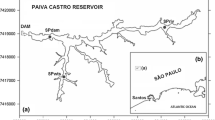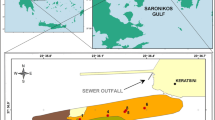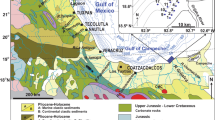Abstract
Sediments are the ultimate sink for contaminants in the marine environment, and physical processes of sedimentation influence the distribution and accumulation of these contaminants. Evaluation of contaminant levels in sediments is one approach to assessing environmental impact; data interpretation depends on consideration of sediment texture and mineralogy, however, which profoundly influence chemical composition. In this study, comparison of potentially contaminated sediments from the production field with control populations was done only within the context of similar (as to texture and organic carbon and carbonate content) sample groups as determined by cluster analysis. Ba, Cd, and Sr are identified as contaminants. Supported by the identification of a well-crystallized expandable clay—possibly bentonite—drilling fluids are a potential source of Ba. Ba and Sr may be unnaturally high because of their abundance in discharged produced formation waters, but may also be naturally controlled by the unique faunal assemblage associated with the structures. Cd is probably derived from corrosion of the structures and assorted debris on the seafloor. In general, contamination is limited to an area within 100 m of the platforms. Furthermore, substantial erosion around platforms has probably effectively removed and dispersed the bulk of the contaminants introduced into the marine environment by the offshore exploration/production operations.
Similar content being viewed by others
References Cited
Anderson, J. B., 1968, Ecology of foraminifera from Mississippi Sound and surrounding waters: Jour Alabama Acad. Sci, v. 1, p. 1–9.
Anderson, J. B. and H. C. Clark, 1977. Geologic results of the Galveston county shore erosion study: U.S. Army Corp of Engineers, Galveston District, Texas, p.
Anderson, J. B. and D. D. Kurtz, 1979, “RUASA”: An automated rapid sediment analyser, Jour. Sed. Petrol., v. 49, n. 2, p. 625–627.
Anderson, J. B., R. R. Schwarzer, and H. C. Clark, 1977. Sedimentology, geochemistry and trace metals:In Environmental assessment of an active oil field in the northwestern Gulf of Mexico 1976–1977, N.M.F.S. Galveston Laboratory, Galveston, Texas, p. 89–164.
Anderson, J. B., R. R. Schwarzer, R. B. Wheeler, and C. L. Hokanson, 1979, Sedimentology and trace metal concentrations in sediments and organisms:In Environmental assessment of an active oil field in the northwestern Gulf of Mexico 1977–1978, N.M.F.S. Galveston Laboratory, Galveston, Texas, p.
Behrens, E. W., 1977, Total organic carbon and carbon isotopes of sediments:In Environmental assessment of an active oil field in the northwestern Gulf of Mexico 1976–1977, N.M.F.S. Galveston Laboratory, Galveston, Texas, p. 737–759.
Berryhill, H. L. (ed.), 1975, Assessment of the south Texas outer continental shelf: Geologic Investigations, October 25, 1974–December 1, 1975: Bureau of Land Management.
Curray, J. R., 1959, Sediments and history of the Holocene transgression: Continental shelf, northwest Gulf of Mexico: Ph.D. thesis, Scripps Inst. Oceanog., 162 p.
Davis, R. A., Jr., 1972, Principles of oceanography: London, Addison-Wesley Pub. Co., p.
Emery, K. O., 1968, Relict sediments on continental shelves of the world, Amer. Assoc. Petrol. Geol. Bull., v. 52, p. 445–464.
Gervirtz, J. L. and R. R. Schwarzer, 1976, Objective classification of discrete sedimentary size-frequency distributions (abs.): Geol. Soc. America Abs. with Programs, South Central Section.
Machemehl, J. L. and G. Abad, 1975, Scour around marine foundations: Offshore Technol. Conf. Proc., OTC paper 2313.
Milliman, J. D., 1974, Marine carbonates, New York, Springer-Verlag, 375 p.
Pinsack, A. P. and H. H. Murray, 1960, Regional clay mineral patterns in the Gulf of Mexico: Clays and Clay Minerals, v. 8, p. 163–177.
Scrudato, R. J. and E. L. Estes, 1975, Clay-lead sorption relations: Environ. Geol., v. 1, p. 167–170.
Siegel, S., 1956, Nonparametric statistics for the behavioral sciences: New York, McGraw-Hill, p. 116–127.
Swift, D. J. P., D. J. Stanley, and J. R. Curray, 1971. Redict sediments on continental shelves: A reconsideration: Jour. Geol., v. 79, p. 322–346.
Turekian, K. K., 1955. Paleoecological significance of the strontium-calcium ratio in fossils and sediments: Geol. Soc. America Bull., v. 66, p. 155–158.
Turekian, K. K., 1956, Rapid technique for determinations of carbonate content of deep-sea cores: Amer. Assoc. Petrol. Geol. Bull., v. 40, p. 2507–2509.
Van Andel, Tj. H., and D. M. Poole, 1960. Sources of recent sediments in the northern Gulf of Mexico: Jour. Sed. Petrol., v. 30, p. 91–122.
Wheeler, R. B., 1979, Environmental trace element geochemistry of sediments of the Buccaneer offshore oil and gas field: Factors controlling concentrations of trace elements in sediments: Master's thesis, Rice University, 176 p.
Wheeler, R. B. and C. Dunning, 1976. Trace element geochemistry of piston cores from western Michigan coastal lakes, Can. Mineral., v. 14, p. 23–31.
Author information
Authors and Affiliations
Rights and permissions
About this article
Cite this article
Wheeler, R.B., Anderson, J.B., Schwarzer, R.R. et al. Sedimentary processes and trace metal contaminants in the buccaneer oil/gas field, northwestern gulf of Mexico. Geo 3, 163–175 (1980). https://doi.org/10.1007/BF02473492
Issue Date:
DOI: https://doi.org/10.1007/BF02473492




